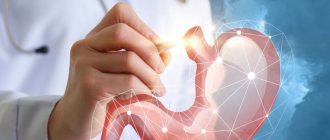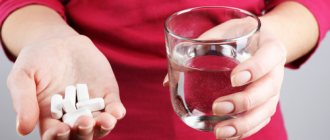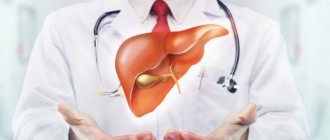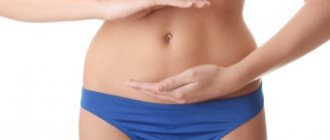Ways to protect your stomach from antibiotics
Despite the possible consequences, antibiotics are the most effective drugs for most diseases. Taking this into account, several recommendations have been developed on how to protect the stomach from antibiotics. By following a number of simple rules, the patient has the opportunity to dramatically reduce the risk of side effects from taking antibiotics.
- First of all, in order to protect the stomach from antibiotics, you must follow the rules for taking them. It is strictly forbidden to take this type of medication before meals, or after a very heavy meal. It is recommended to use antibiotics after finishing a light meal;
- Doctors also recommend eating foods and products that have enveloping properties to protect the stomach from antibiotics.
List of medications that support intestinal microflora when taking antibiotics
Eating such food is guaranteed to reduce irritation on the mucous membranes of all organs of the gastrointestinal tract. Such dishes can be soups, cereals, boiled vegetables, and jelly.
When are probiotics most effective?
The list of diseases and pathological conditions for which the use of probiotic complexes is recommended is quite extensive. For antibiotic-associated diarrhea, American gastroenterologists, for example, recommend a combination of strains of Lactobacillus plantarum and Bifidobacterium infantis in a “community” with the fungi Sacchromyces boulardii. For infectious diarrhea caused by ARVI pathogens, two types of lactobacilli are indicated - Lactobacillus casei and Lactobacillus rhamnosus.
Of considerable importance to achieve the desired effect is the survival rate of microorganisms that we obtain from probiotic complexes. In other words, how high is their biochemical activity in the gastrointestinal tract. In addition to the above-mentioned lacto- and bifidobacteria, propionic acid bacteria Propionic bacterium are among the most “tenacious”. They not only restore the gastrointestinal tract after the “invasion” of antibiotics, but also act as immunomodulators. In addition, they suppress the development of many mutations, reduce the toxic effects of a number of chemicals and promote the growth and development of fecal bifidobacteria.
2+
Back to list Previous article Next article
Why is it necessary to protect the stomach from antibiotics?
The thing is that the antibiotic, having a semi-synthetic or natural origin, suppresses the growth and reproduction of bacteria in the human body. The problem lies in the fact that this type of drug generally does not act selectively, which leads to the fact that in the process of fighting pathogenic bacteria, damage is caused to beneficial bacteria, of which there are many in the human body, as well as to the human body as a whole. The main blow of all antibiotics, without exception, is taken by the gastrointestinal tract, namely the digestive system.
This fact is explained by the fact that in most cases, antibiotic drugs are taken in the form of tablets or capsules orally. By destroying bacteria, antibiotics make the human stomach extremely vulnerable, which can lead to
diarrhea,
flatulence,
sharp pain in the abdominal area,
and also cause vomiting and nausea.
The basic rule of taking antibiotics to protect the stomach
But the most important thing in protecting the stomach from antibiotics is a complete and unconditional refusal of self-treatment. Having a number of side effects, and being perhaps the most effective means in the fight against most diseases, antibiotics can cause irreparable harm to health if they are taken incorrectly.
Therefore, before taking such strong drugs, it is imperative to consult a doctor.
Fields marked *
required. HTML tags are disabled.
Very often, having determined the cause of the patient’s illness, the doctor may prescribe antibiotics. These drugs should be used strictly according to medical recommendations, otherwise the treatment process is unlikely to be effective. In this case, it is necessary to adhere to certain rules that determine how often antibiotics can be taken, the dosage of the drugs, and also take into account some other features.
Impact of antibiotics on microflora
Antibiotics are indispensable in the treatment of a large number of serious diseases of the respiratory tract, ENT organs, genitourinary system, and infectious intestinal diseases. Therefore, one can hardly expect that medical practice will abandon their use - and this is not necessary! But, since these substances do not have a selective effect, destroying both pathogens and beneficial bacteria, their side effects are often no less pronounced than the therapeutic effect. Much to our regret.
The most common side effect is considered to be indigestion. Stool upset and so-called antibiotic-associated diarrhea (AAD) . The frequency of its occurrence directly depends on the class of drugs taken and varies within 30%. The development of AAD directly stems from dysbiosis , which occurs due to the destruction of beneficial intestinal microflora. As a result, the human body is left without its natural helpers, which contribute to our absorption of useful substances, take part in the synthesis of vitamins, regulate stool and improve intestinal motility. One of the main targets of antibiotics are lactobacteria and bifidobacteria, which die in large numbers from such drugs. Instead, colonies of opportunistic microorganisms begin to grow, releasing their metabolic products - toxins. abdominal pain and a number of other unpleasant symptoms occur Colitis is also common in such cases .
The metabolic function of the intestine , or rather the microflora inhabiting it, seriously Carbohydrates are poorly digested, which leads to their poor absorption by the body. The process of breaking down fiber into SCFAs - short-chain fatty acids - is disrupted . As a result, the intestinal cells begin to experience a lack of nutrition, and the trophism of its mucous membrane deteriorates. Water absorption and bile acid metabolism are also impaired. Since the latter actively stimulate the production of intestinal secretions, secretory diarrhea occurs.
Under the influence of antibiotic drugs, colonization resistance of beneficial intestinal microorganisms decreases. They become unable to suppress the growth of harmful bacteria with the same effectiveness. In competition with the latter, lacto- and bifidobacteria noticeably lose their positions and gradually pathogenic microflora begins to “host” the receptors of the intestinal mucosa. Result: local immunity due to decreased production of immunoglobulin A and lysozyme is noticeably reduced . If the mechanism of the destructive effect of antibiotics on beneficial microflora is not stopped, then inflammatory processes in the colon mucosa and its inflammation become so pronounced that restoring the original state of health becomes a very difficult task, requiring a lot of effort and time.
Duration of treatment
As a rule, the duration of the course of treatment prescribed by the doctor is from 7 to 10 days. Sometimes, when using a number of special drugs, the period of use can be no more than 6 days. However, whatever the appointed time, it must be observed very strictly. While some patients, immediately after their health improves, independently reduce the dose of the antibiotic and even stop taking it completely. Such actions can lead to undesirable consequences:
- the body that has not completely gotten rid of the infection continues to get sick;
- complications arise;
- and the worst thing about this situation is that the bacteria become resistant to the drug.
Some antibiotics have a long-lasting effect, due to which they can be taken for only 3 days. Among them is sumamed, used as a medicine for sore throats. However, there is another option when the period of taking the drug does not exceed 3 days - for example, if it turns out to be unable to cope with bacteria during this period, and the patient’s well-being does not improve. In this case, the attending physician will prescribe a different antibiotic.
Reception frequency
When answering the question of how often you can take antibiotics, it is worth noting that each of them has its own frequency of administration. Sometimes this is only once a day, while some drugs can be taken several times more often. The frequency depends on the time during which the medicine exists in the body and has a positive effect on it. For example, a three-time dose is prescribed if the antibiotic is effective for 8 hours, after which it is eliminated through the liver or kidneys. By the way, this is exactly the eight-hour interval that should exist between taking the medicine.
If for some reason the patient did not have time to take the antibiotic in a timely manner, for example, before breakfast, and the time is already moving toward lunch, the dosage should not be doubled. Indeed, in this case, the effect of the drug will not double - the body will simply receive an increased portion of the drug and may not be able to cope with such an amount. Due to the toxic effect of antibiotics, bacteria may die, but various internal organs may be damaged, and health will deteriorate. Moreover, after some time the disease will subside, and side effects from exceeding the dosage will have to be treated for a long time.
An unpleasant consequence of reducing the dose (if the patient decides, for example, to completely skip taking the medicine) is the same increase in the resistance of the infection to the drug, which also occurs if the duration of the course of treatment is violated. But bacteria that have become immune to the drug will be much more difficult to deal with.
Drug compatibility
Patients are often interested in the question: how to take medications correctly so as not to encounter unpleasant consequences? The answer is simple, you need to follow certain rules.
So, what should you do if your doctor prescribes antibacterial therapy:
- We take antibiotics at the same time.
- We wash them down with enough water.
- We follow a diet.
But, perhaps, the best advice is to consider the compatibility of taking antibacterial agents and drugs for dysbacteriosis.
How to take the tablets:
- we eat them after eating;
- We do not combine 2 types of medications together (we take antibiotics separately, probiotics or absorbents separately).
The patient takes good medications in courses. Even after completing treatment with antibiotics, the doctor may recommend continuing therapy with probiotics or prebiotics if the patient's condition causes concern to the doctor.
Help: If the patient took antibiotics and drank sorbents or phenomenal drugs. But at the same time I am faced with signs of dysbiosis, then therapy needs to be strengthened with other medications.
What to take, at what time and according to what regimen you should ask your doctor. If therapy does not help normalize the patient’s condition, then it is subject to correction.
Other features of antibiotic treatment
Often, medication is prescribed, tying it not just to a specific time, but also to food. Some antibiotics should be taken only before meals, others after meals, and others absolutely at any time. This happens because some drugs are able to bind to food, while others are not. Some antibiotics taken on an empty stomach can damage the stomach lining. If you consume them after meals, there will be no harm to the body.
Regardless of food intake, it is allowed to use some types of macrolides (such as josamycin, spiramycin and clarithromycin) and cephalosporins. On an empty stomach (about an hour before breakfast or lunch, and no earlier than 2 hours after a meal), take ampicillin and those macrolides that are not listed above. It is advisable to consume various types of cefuroxime suspensions and tablets with food - this is how their absorption will be almost one hundred percent.
In addition to observing frequency and connection with food intake, the patient should know about antibiotics and how to take them correctly, taking into account contraindications and side effects. He is also required to:
- do not consume certain types of products specified in the instructions while taking the medication (for example, for furazolidone this is cheese, wine, beer, beans and smoked meat);
- Do not drink alcohol under any circumstances, which is contraindicated in all patients whose treatment includes antibiotics. Moreover, if you drink alcohol together with isoniazid, metronidazole, furazolidone and erythromycin, the consequences for the body will be especially serious;
- Avoid preservatives and try to include more light and healthy foods in your menu.
Recovery after antibiotics
Any course of antibiotics requires a recovery period, during which not only should you not take the same drug or any other similar medications, but it is also recommended:
- follow a certain diet, which should avoid fried, spicy and salty foods, and also increase the frequency of meals to 5 times a day (reducing portions accordingly);
- use enzyme preparations such as Hermital, Micrazim, Creon for recovery for 10–14 days;
- Take substances called probiotics to restore gut dysbiosis. These include Bifiform (2 rubles per day for 10 days), Linnex (3 rubles per day, about 7 days) or Acipol (3-4 rubles per day, up to 2 weeks);
- undergo a two- or three-week recovery course with the help of hepatoprotectors, erythromycin, tetracycline, sulfonamides, rifampicin and other similar drugs;
- avoid hypothermia.
Using all these recommendations, the patient can recover much faster than without paying attention to them. This will also help you avoid side effects associated with this infection, and even return to normal faster if the same disease occurs again.
How to protect your stomach when taking antibiotics
Antibiotics are a group of drugs that have many side effects, but we cannot do without them. Almost all infectious diseases are caused by one or another strain of pneumococcal infection. Depending on the quantity of the virus that has penetrated, as well as the protective forces of the human immune system, the virus can penetrate and cause a mild or severe form of the disease.
Commercials that impose on our consciousness the effectiveness of antibiotics force us to take them uncontrollably and engage in self-medication even with the slightest ailment. Of course, there are doctors who find it easier to play it safe and write a prescription for antibiotics than to choose a more gentle course of treatment.
Many people do not even suspect that just a few doses of antibiotics can kill the beneficial microflora of the stomach and lead to problems with the gastrointestinal tract. At the same time, having identified them in time, you again need to select the correct course of drugs. Undoubtedly, a correctly selected course of antibiotic treatment also eliminates the infection that has settled in the body, but the price of such treatment is often abdominal pain, diarrhea or, conversely, constipation, changes in stool consistency, poor digestion of food, and, accordingly, the body does not receive enough nutrients contained in consumed products.
The WHO has universally stated that every professional doctor must follow this rule: if an old-generation antibiotic gives results, you cannot switch to a more modern group. But let's think about whether the doctor has ever analyzed the effectiveness of your previous treatment or at least wondered what drugs from the group of antibiotics you took last time. Most likely the answer will be negative.
However, it is worth considering that an incorrectly selected group of antibiotics may not have the desired effect or may have little effect on pathogens, which requires longer use of antibiotics and, as a rule, is accompanied by many intestinal problems. Symptoms such as thrush in women, diarrhea, increased gas formation and much more can become unpleasant companions and result from long-term use of antibiotics.
Such symptoms indicate the development of dysbiosis - excessive proliferation of bacteria in the intestines.
Under the influence of the antibiotic, the intestines become thinner. In this case, most beneficial viable bacteria die. Moreover, the body loses a lot of water, which leads to even greater death of beneficial microflora.
Recovery after antibiotics is an important process that will eliminate all unpleasant consequences for the intestines. Don't forget that our immune system starts from the stomach. Its dysfunction can lead to a new infectious disease and you will have to undergo antibiotic therapy again.
What medications should you take after antibiotics?
If a person has been faced with the need to take antibiotics at least once in his life, then he is probably familiar with the importance of recovery after antibiotics.
Antibiotics are an effective medicine in the fight against harmful microorganisms that cause infections and inflammation.
We take these medications during seasonal colds, as well as for tissue inflammation, after operations, in order to prevent complications.
However, it is no secret that antibiotics that have saved millions of lives also have a downside.
A kind of payment for their effectiveness is severe toxic effects and the death of beneficial microflora.
Some of the new generation of drugs are already partially devoid of these shortcomings, but the vast majority of drugs against bacteria still leave behind unpleasant consequences.
Doctors, when prescribing a course of antibacterial drugs, always tell the patient how to recover after taking a course of antibiotics.
Sometimes, in a hospital setting, full rehabilitation after antibiotics is carried out if a patient with immunodeficiency had to undergo aggressive treatment.
But in this article we will rather talk about how to cleanse the body after antibiotics at home after a domestic situation: for example, treating a cold.
What harm do antibiotics cause?
Before proceeding directly to the description of the recovery course, it is necessary to explain why recovery after antibiotics is needed. As already mentioned, after long-term use of antibiotics, along with pathogenic microflora, beneficial microflora also die - for example, digestive bacteria, which are harmless to humans and help digest food.
As a result, after the use of antibiotics, an imbalance of the intestinal microflora occurs (if we are talking about tablets, and not about antibiotics in ampoules or local remedies). The “vacant” place of dead bacteria immediately begins to be occupied by other microorganisms - either other bacteria or protozoan fungi, which begin to grow into the intestinal walls, disrupting its activity.
Antibiotics have an even stronger effect on a woman’s body. For example, a common problem for the fair sex is the appearance of thrush after taking antibiotics. This is due to the fact that antibiotics, even taken in tablet form, can have a systemic effect on the body, acting not only in the intestines, but also on the mucous membranes.
Complications after treatment with antibiotics can be very different. The main and most harmless ones are flatulence, diarrhea, prolonged constipation and other intestinal disorders. In severe cases, the liver is seriously damaged and other toxic effects develop.
Let us note once again that recovery after taking antibiotics is a normal procedure that is part of the course of treatment.
This does not mean that antibiotics are a bad remedy and you should avoid using them at all costs (on the contrary, it can be dangerous to health), but it is necessary to help your body wisely.
There is also no need to engage in amateur activities - how to restore the body should either be suggested by the doctor, or the patient himself should coordinate his initiative with him.
Is restoration really necessary?
Many supporters of a healthy lifestyle and treatment with folk remedies are so fanatically discussing cleansing the body of toxins after antibiotics, as if the person had not undergone a course of treatment, but had been poisoned.
Firstly, not all patients require restoration of the body after taking antibiotics.
If a person, for example, is being treated for a cold or an inflammatory process, but does not have any serious chronic diseases, is not elderly and does not have an immunodeficiency, then a standard course of antibiotics will not harm him.
It’s another matter if the course of treatment is delayed and side effects become obvious - diarrhea or flatulence appears, the supply of nutrients from the intestines is disrupted, and bloating may occur.
Secondly, rehabilitation after a course of antibiotic treatment is necessary not only as restoration of the body after antibiotics, but, above all, as restoration of the body after an illness.
Bacteria themselves cause much more damage than can be caused by drugs - antibiotics, so the question should not be so much about how to recover from antibiotics, but rather about how to recover and eliminate the consequences of the illness.
Thus, after a course of antibiotics, people who:
- were weakened at the time of treatment;
- experience side effects of antibiotics.
For other patients, after antibiotics, you just need to follow a gentle regimen, take a course of vitamins and rest well.
How to minimize the negative effects of antibiotics
In order not to think about how to restore the body after antibiotics, you need to follow the rules for taking them, which will help preserve the beneficial microflora bacteria and the health of other organs.
First of all, you should know regarding antibiotics that you need to take these drugs only as prescribed by a doctor and undergo tests. The most toxic antimicrobial drugs are broad-spectrum drugs; it is much more effective to identify the pathogen at the very beginning of the disease by doing a culture of the flora, and take a selective drug.
Under no circumstances should you take antibiotic medications without a doctor’s prescription, because This leads not only to intoxication of the body, but also to the fact that bacteria get used to the drug and become resistant to its effects. This is already dangerous not only for a specific person, but also for everyone who comes into contact with him.
The second golden rule is that you need to take antibiotics strictly in the dosage and duration that was prescribed by your doctor. A smaller dose and duration can lead to the bacteria becoming resistant and surviving, so it is necessary to drink the entire course, even if the patient seems to be healthy.
Diet during and after the course of treatment is an important part of preserving the microflora. After antibiotics, to restore the functioning of the liver and intestines, it is good to eat fermented milk products, porridge (especially oatmeal), bread containing wholemeal flour and the addition of bran, fruits and vegetables, a lot of greens, and nuts.
To eliminate symptoms such as flatulence, diarrhea, constipation, drink several glasses of kefir a day, or at least one glass at night. For those people who cannot stand the taste of kefir, there is an alternative - fermented baked milk, sourdough, drinking yoghurts with a milder taste.
Cleansing after antibiotics
The first stage of recovery after completion of antibiotic treatment is detoxification. At this stage, it is necessary to remove all waste and toxins from the body, as well as residual traces of the drug. How to cleanse the body after taking antibiotics? To do this, there are several basic techniques that you can either combine or choose one you like.
The main assistant in detoxification is activated carbon. There are other drugs to remove toxins, but they are needed more for cases of poisoning.
No other medicine can do better and cheaper for rehabilitation at home than activated carbon. The principle of operation of coal is to absorb toxins, bind toxic substances into harmless complexes and remove them from the body.
Both children and adults can drink this remedy after antibiotics - activated carbon is absolutely harmless.
Source: https://gemoglobin.top/kakie-lekarstva-nuzhno-prinimat-posle-antibiotikov/
What to take when taking antibiotics
Taking antibiotics is a whole set of procedures that must be followed. In order for the effect of the drug to be aimed only at eliminating the infection, you need to know what to drink with antibiotics for microflora for an adult, as well as how to eat while taking antibiotics.
In answer to these questions, we can say with confidence that taking antibiotics should be combined with probiotic therapy, as well as diet.
Probiotics are a dry powder that contains millions of live lacto- and bifidobacteria. The form of release of the drug can be varied: capsules, tablets, suspension. Previously, the effective action of beneficial bacteria was completely destroyed by the action of antibiotics, without even reaching the intestines, so they were prescribed only after a course of antibiotics. To date, innovative developments have made probiotics resistant to the action of antibacterial agents, as well as to hydrochloric acid, which is found in the stomach. Such biologically active drugs include: Lactobacterin, Bifidumbacterin, Sporobacterin, Probifor, Acipol, Linex, etc.
It is also important to support the liver during treatment with antibacterial agents, because it is the liver that is responsible for cleansing the body. To maintain it, drugs from the group of hepatoprotectors or a decoction of thorns are used.
What drugs are taken together with antibiotics for dysbiosis - new from the world of medicine
Prevention of dysbiosis when taking antibiotics is an important part of treatment and helps to get rid of unpleasant phenomena that may arise during antibacterial therapy.
Prevention includes several stages. It is carried out not only with the use of tablets. It is based on simultaneous adherence to simple but effective nutritional rules and individually selected drug treatment.
Why does dysbiosis occur?
Taking antibiotics is not beneficial. Despite the fact that drugs of this class kill pathogenic bacteria. They have a detrimental effect on the beneficial microflora of the intestines and stomach.
The use of drugs leads to various complications. Most often, during the period of antibacterial therapy, the patient experiences:
- Intestinal dysbiosis and intestinal disorders.
- Disorders of the pancreas and liver.
- Problems with joints, impaired mobility of limbs.
Attention! Dysbacteriosis while taking antibiotics occurs more often than other complications. Because the gastric microflora comes face to face with the medicine. The tablets enter the stomach from there into the intestines.
The medicine begins to act in the stomach, which leads to the massive death of beneficial bacteria. Against this background, dysbiosis occurs.
Intestinal microflora dies under antibacterial agents. A favorable environment for the growth and reproduction of pathogenic microflora appears in the stomach and intestines.
The development of dysbiosis from antibiotics occurs quickly. Within a few days from the moment the patient starts taking the drugs, the first signs of disruption of the gastrointestinal tract appear.
A person cannot refuse to use antibacterial drugs; he is forced to continue the course of treatment. Even when faced with dysbiosis and its unpleasant symptoms, antibiotics cannot be stopped.
Broad-spectrum drugs are especially destructive; they are highly effective and toxic. Medicines can also have a narrow focus; such drugs are not so dangerous for the intestines and stomach. But such antibiotics are not highly effective and are prescribed less frequently.
Treatment should include determination of sensitivity to antibiotics and bacteriophages. For this reason, it is advisable not to prescribe medications of this class on your own, especially if there are no indications for such therapy.
Prevention of dysbacteriosis
Before you start taking medications for dysbiosis, you should think about whether antibiotics are being taken correctly? Prevention of gastrointestinal disorders is carried out in several stages, it is based on:
- on proper nutrition;
- compliance with medication regimen;
- on reducing the toxic effects of drugs on the human body.
Dysbacteriosis from taking antibiotics will not take long to occur if you eat incorrectly. Problems will constantly bother you, and antibacterial therapy will only worsen them. Proper nutrition as part of prevention helps prevent the development of intestinal problems or at least reduce the manifestations of dysbiosis.
Diet while taking antibiotics
An important aspect of antibiotic treatment is the drinking regime and food menu. Few people know, but you need to take an antibacterial tablet with 200-250 ml of water. In this case, be sure to follow the instructions for taking the drug, most often 2 hours before or after meals.
A properly formulated diet is part of the therapy that will be required for effective and faster treatment.
By including dairy products in your daily menu, which are rich in live cultures of lacto- and bifidobacteria, you can not only support your body during illness, but also improve intestinal motility.
Natural yogurt is also used in the daily menu. This product is especially relevant before bedtime. It populates the intestines with beneficial bacteria, so you won’t feel nauseated in the morning, which often happens when taking antibiotics.
Dietary fiber, which is enriched with greens (parsley, lettuce, dill, etc.), carrots, white cabbage, oatmeal, apricots and beets, should also be present in the diet.
Fresh fruits and vegetables are indispensable for colds: onions, especially green feathers, garlic, artichokes, bananas. A large dose of probiotics is found in a serving of wholemeal onion soup.
To restore strength you will need a lot of protein, so you need to increase your fish intake. The best choice would be lean fish such as cod, hake, halibut, red mullet, etc.
Probiotics are the best protection for microflora
Normoflorins L, B, D
How can we normalize the intestinal microflora that has become a victim of traditional antibiotic therapy? This question is more than relevant today for a large number of people, but there is only one answer - only probiotics . This is the name for special products that can not only support and restore normal intestinal microflora, but also populate the intestines with such microflora. The uniqueness and advantage of probiotics is that they contain live strains of beneficial bacteria. When they colonize the intestines, the opportunistic flora is forced to give up their positions. As a result, the digestive system is restored to its healthy state prior to the course of antibiotics.
In addition to restoring normal intestinal function and improving digestion, probiotics participate in strengthening local and general immunity, and synthesize much-needed vitamins such as groups B and K. All these vital processes occur thanks to the active work of lacto- and bifidobacteria, which are part of probiotic complexes. To forestall your possible doubts, we note: the use of probiotics as a restorative agent after antibiotic therapy is absolutely safe. As for the effectiveness, it can be judged by the example of biocomplexes known as Normoflorins . These are special natural preparations, produced in liquid form, which are a mixture of lactobacilli and bifidobacteria with their metabolic products - vitamins and minerals, antimicrobial nutrients and organic acids. In addition, Normoflorins contain a very valuable ingredient - the disaccharide lactitol, which serves as excellent nutrition for a person’s own microflora, thereby stimulating its growth and development.
The first Russian scientist to seriously study the effect of probiotics on the restoration of microflora was I.I. Mechnikov. He based his work on observations of lactic acid bacillus, arriving at excellent results. However, probiotics are not necessarily just bacteria. These may include other protozoa. Let's say yeast.
Comparative table of action and composition of pro- and prebiotics
| Properties | Prebiotic | Probiotic |
| Action | stimulation of the growth of natural intestinal microflora | colonization of the intestine with microflora from the outside |
| Compound | substances that provide food for beneficial bacteria found in the intestines | living cells of beneficial intestinal microflora: dactobacilli, bifidobacteria, etc. |
| Passage through the digestive organs | one of the main properties of prebiotics is that they are not digested and reach the intestines in their entirety with unchanged properties | approximately 5-10% of probiotics taken can reach the intestines in their original form |
| Efficiency | taking prebiotics stimulates an increase in the population of bacteria beneficial to the body | There are about 500 types of beneficial bacteria in the intestines; a probiotic can contain no more than 1-2 types |
Drugs for dysbiosis: classification
What to drink at the first signs of intestinal upset? You can use several drugs that will help not only reduce the toxicity of drug therapy, but also restore the microflora in the intestines.
Taken with antibiotics for dysbiosis:
Signs of intoxication may be added to the symptoms of dysbacteriosis. Absorbents will help get rid of them. They can be taken along with antibiotics. Absorbents have a beneficial effect on the functioning of the gastrointestinal tract.
Adults can take absorbents from the moment treatment begins. They absorb toxins and harmful substances, helping the body cope with the harmful effects of medications. They have a good effect when carrying out complex therapy.
Sorbents only absorb harmful substances and stop diarrhea, but they are able to restore beneficial microflora in the stomach and intestines.
Prebiotics are often used along with antibiotics to prevent dysbiosis. These are drugs that create a beneficial environment in the stomach and intestines for the growth and reproduction of beneficial microorganisms.
Products in this class contain microelements and dietary fiber, amino acids and fiber. Treatment with such drugs stimulates the growth of beneficial microorganisms, due to which digestive problems go away.
In the treatment of intestinal dysbiosis in adults, prebiotics are quite effective. They do not contain befidobacteria and lactobacilli, but they help restore the natural intestinal microflora.
Today it is difficult to surprise anyone with a product that contains beneficial microorganisms. Similar drugs are also taken for dysbiosis when taking antibiotics. Together with absorbents or prebiotics, such drugs are quite effective. To restore intestinal microflora in adults and children, probiotics are most often prescribed.
Note: Drugs of this class cannot completely neutralize the effect of antibiotics. But they will significantly improve the condition of the digestive organs.
When drinking vitamins, you should not expect changes in the intestines. This treatment is aimed at strengthening the body. Stabilization of the immune system. The rules for taking vitamin complexes are indicated on the packaging. There is no particular difference which drug will be preferred.
It is desirable that the complex include vitamins: E, C, A and group B. Such products are prescribed to adults and children. To strengthen the body and as a preventive treatment. During the period of exacerbation of viral and colds.
Traditional methods of intestinal restoration after antibiotics
Fresh blueberries or fresh berries will help remove the remaining antibiotics from the body. Impaired stomach function can cause increased gas formation. To eliminate such unpleasant symptoms, you need to make the following tincture:
- For the recipe you will need: 0.5 l kefir, 2 cloves garlic, 1 onion, 3 sprigs dill, 3 sprigs parsley, 1 tsp St. John's wort inflorescences, 1 tsp chamomile.
- All ingredients must be crushed and placed in a liter container.
- Add 0.5 liters of boiling water.
- Leave for 30 minutes.
- The resulting infusion must be filtered.
- Take 200 ml per day, 1 time per day.
This herbal decoction is no less useful: St. John's wort 1 tsp, sage ½ tsp, tansy 1/3 tsp. Pour boiling water over the ingredients and leave for 2 hours. Filter and take 30 minutes before meals, three times a day.
Such herbal medicine techniques are also effective for dysbiosis. Regular use of herbal infusion will show its results within 2 weeks.
How long does it take for antibiotics to leave the body?
But the question remains how long it takes for antibiotics to be eliminated from the body. Most drugs in this group are excreted in the urine. The time period depends on many factors, for example, the form of release, the chemical composition, and the age of the patient. The average is 8 hours after the last dose, the maximum is 7 days, but after two days the number of units of the drug in the urine becomes minimal.
Another popular question is whether there is a faster way to remove antibiotics from the body after treatment. In order to get rid of toxic decay and drug residues, it is necessary to drink a large amount of liquid; it is also recommended to include fermented milk products in the diet, which help remove toxic substances from tissues.
We recommend reading










